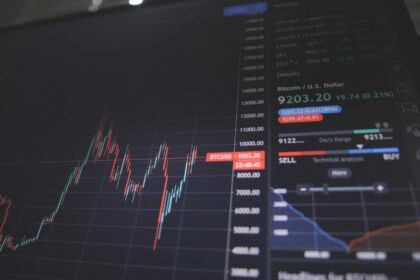To oversee the value and changes in your digital asset collection, using specialized software solutions is key. Mobile and desktop applications designed for this purpose allow users to link wallets and exchange accounts, providing real-time updates on holdings without manual calculations. This approach saves time and reduces errors when assessing overall worth.
Several platforms offer customizable dashboards that display performance metrics such as gains, losses, allocation percentages, and historical charts. These interfaces help visualize trends and make informed decisions based on up-to-date information. Integration with multiple sources ensures all assets are accounted for in a single view.
Selecting tools with automatic synchronization capabilities eliminates the need for constant manual input, making it easier to maintain an accurate overview daily. Beginner-friendly apps often include tutorials or step-by-step guides to assist newcomers in setting up their accounts correctly. By leveraging these resources, managing your investment summary becomes more transparent and accessible.
How to Track Your Crypto Holdings Efficiently
The most straightforward method to observe the value and fluctuations of your digital assets involves using dedicated applications designed for this purpose. These tools provide real-time updates on asset valuation, transaction history, and performance metrics across multiple exchanges and wallets. Users can consolidate their investments from various sources into a unified view, which simplifies management and decision-making processes.
Many tracking solutions support automatic synchronization with exchange accounts via API keys or manual input for wallets by importing public addresses. This functionality enables continuous monitoring without the need for constant manual updates. Additionally, such platforms often offer portfolio analytics that break down gains, losses, and allocation percentages, providing a clearer picture of asset distribution and risk exposure.
Popular Applications to Monitor Digital Asset Collections
Leading software options include CoinStats, Delta, Blockfolio (now FTX), and Kubera. Each offers unique features tailored to different user needs:
- CoinStats: Enables syncing with over 300 exchanges and supports DeFi wallet integration, allowing users to view both centralized and decentralized holdings in one place.
- Delta: Provides detailed charts and alerts for price changes; suitable for investors who want granular control over notifications related to their investments.
- Blockfolio: Focuses on mobile convenience with an intuitive interface, including news aggregation relevant to tracked assets.
- Kubera: Offers multi-asset tracking beyond cryptocurrencies–stocks, bonds, real estate–helping investors maintain a comprehensive financial overview.
The choice depends on factors such as supported exchanges, wallet compatibility, user interface preferences, and additional analytics capabilities required by the investor.
Technical Considerations When Using Portfolio Monitoring Tools
Security remains paramount when linking external services with exchange accounts or wallets. Utilizing read-only API keys limits permissions strictly to data retrieval without enabling transactions. For non-custodial wallets, entering public addresses ensures privacy since no private keys are shared. It’s advisable to review the app’s security protocols and reputation before integration.
A well-configured monitoring system incorporates automated alerts based on predefined thresholds–such as sudden changes in asset value or portfolio diversification shifts. These notifications assist users in reacting promptly to market volatility or rebalancing needs without continuously checking dashboards manually.
An example scenario: An investor holding Bitcoin on Binance and Ethereum in a hardware wallet can integrate both into a single dashboard using CoinStats by connecting Binance’s API key (read-only) and entering the Ethereum address manually. This setup provides an up-to-date snapshot of overall holdings while maintaining stringent security practices.
The progressive mastery of these tools builds confidence in managing cryptocurrency investments effectively. By understanding how to leverage application features correctly–including syncing methods, alert configurations, and diversification insights–individuals enhance their ability to make informed decisions aligned with personal financial goals.
Choosing User-Friendly Tracking Tools
Selecting applications that allow clear observation of asset performance is fundamental for managing digital investments effectively. Tools with intuitive interfaces and automated synchronization features reduce the complexity of maintaining detailed records, enabling users to observe fluctuations and distribution without manual input errors.
Applications designed for monitoring investment changes offer various data visualization options such as charts, heatmaps, and real-time updates. These visual aids enhance understanding of asset allocation and market behavior, making it more straightforward to analyze overall value changes over time.
User Experience and Accessibility Considerations
Ease of navigation plays a key role in choosing software that facilitates portfolio supervision. Programs with customizable dashboards let individuals prioritize information relevant to their interests, whether it’s daily gains or historical trends. Additionally, mobile compatibility ensures access on-the-go, supporting continuous oversight without tethering users to desktops.
Security remains paramount when connecting wallets or exchange accounts. Trusted platforms employ encryption and two-factor authentication methods to protect sensitive data during synchronization processes. Users should verify these security measures before integrating personal investment details into any application environment.
Integration capabilities with multiple sources–such as decentralized exchanges, hardware wallets, and fiat gateways–enhance the comprehensiveness of monitoring tools. By consolidating diverse holdings into a unified view, investors can assess diversification levels more accurately and make informed decisions based on aggregated metrics rather than fragmented snapshots.
Performance tracking accuracy depends on timely updates from data providers and stable API connections. Some services offer manual correction options for transactions not automatically detected due to network limitations or token inconsistencies. This flexibility ensures recorded values reflect actual holdings even in complex scenarios involving staking rewards or cross-chain transfers.
Importing Wallet and Exchange Data
To monitor your asset holdings effectively, begin by importing wallet and exchange data into dedicated management tools. Most applications support connection via API keys for exchanges or allow manual entry of wallet addresses to fetch balances directly from the blockchain. For instance, platforms like CoinTracker or Delta enable users to link multiple wallets and exchange accounts in one place, consolidating transaction histories and current values automatically.
When integrating data sources, it is vital to ensure accuracy by verifying imported transactions against on-chain records or exchange statements. This step minimizes discrepancies caused by delayed updates or unsupported tokens. Advanced tools often offer reconciliation features that highlight mismatches between reported holdings and actual balances, allowing users to correct inconsistencies proactively.
Technical Methods for Data Integration
API integration remains the most efficient method for continuous synchronization with exchange accounts. By generating read-only API keys (with trading and withdrawal permissions disabled), users can securely allow apps to retrieve transaction history and real-time balances without exposing sensitive credentials. Wallet import typically involves submitting public addresses; the app then queries blockchain nodes or third-party indexers like Etherscan or BscScan to gather token holdings.
Some applications also support importing CSV files exported from exchanges, which facilitates batch uploading of historical trades when direct API access is unavailable. This method demands attention to format compatibility; popular standards include formats from Binance, Kraken, and Coinbase Pro. Tools often provide templates or guides for preparing these files correctly.
Monitoring Performance Through Aggregated Views
Once data is imported, portfolio management software generates aggregated views reflecting total asset distribution, profit/loss calculations, and performance metrics over various timeframes. These insights assist in making informed decisions based on comprehensive snapshots rather than fragmented data points scattered across multiple services. For example, visual charts depicting allocation percentages among assets like Bitcoin, Ethereum, and stablecoins help users assess diversification at a glance.
Regularly updating connections ensures ongoing accuracy as new transactions occur. Some tools feature automated refresh intervals ranging from minutes to hours depending on provider limitations and user preferences. Setting appropriate update frequencies balances real-time responsiveness with resource consumption.
Practical Recommendations for Everyday Users
- Start Small: Import a single wallet address first to familiarize yourself with the tool’s interface before adding multiple accounts.
- Secure Access: Always use read-only API keys without withdrawal rights when linking exchange accounts to reduce security risks.
- Verify Data: Cross-check imported information periodically using blockchain explorers or official exchange reports.
- Explore Features: Utilize alerts for significant portfolio changes or price thresholds available in many apps.
This approach builds confidence gradually while providing reliable means of oversight suitable for both novices and more experienced enthusiasts aiming to maintain an organized overview of their digital assets’ status and trends.
Setting alerts for price changes
Utilizing specialized tools to set notifications on asset price fluctuations enhances the ability to oversee investments efficiently. Many applications offer customizable alert features based on percentage moves, absolute values, or time intervals, allowing users to maintain awareness of significant market shifts without constant manual checking.
Monitoring performance through these alerts aids in timely decision-making and risk management. For instance, setting a threshold alert at a 5% drop or rise in value can trigger immediate updates via push notifications, SMS, or email, ensuring that important changes are not missed even when away from trading interfaces.
Technical aspects and practical implementations
Several platforms support advanced alert configurations with options like trailing stops or volume-based triggers. Apps such as Coinigy and Blockfolio provide multi-exchange integration, enabling comprehensive oversight across diverse holdings. These solutions allow users to tailor alert criteria per asset or group of assets within their investment collection.
A practical example involves combining alerts with historical volatility data: by analyzing standard deviation over recent periods, investors can set dynamic thresholds that adjust according to typical price behavior rather than fixed percentages. This adaptive approach reduces false alarms during normal fluctuations and highlights genuinely unusual movements.
- Alert types: percentage change, price crossing specific levels, volume spikes
- Delivery methods: app notifications, emails, SMS
- Customization: individual asset settings versus portfolio-wide alerts
Integrating these alert systems into daily routines simplifies maintaining an overview of asset allocation effectiveness. It also supports evaluating the impact of external factors like regulatory announcements or network upgrades on token valuations by providing real-time feedback mechanisms.
The combination of precise notification settings with reliable delivery channels empowers investors to respond promptly and make informed adjustments. Encouraging experimentation with different alert thresholds and timing can lead to discovering optimal setups tailored to individual investment strategies and comfort levels.
Analyzing Asset Allocation Quickly
To evaluate asset distribution efficiently, begin by utilizing specialized software designed for financial management. These platforms offer clear visual representations such as pie charts and heat maps that facilitate immediate understanding of how investments are spread across various tokens and categories. For example, applications like CoinStats and Delta allow users to connect wallets and exchanges directly, enabling an automated reflection of holdings without manual input.
Monitoring investment distribution involves focusing on diversification metrics and risk exposure percentages. Tools with built-in algorithms calculate these factors in real-time, highlighting overconcentration in specific assets or sectors. By observing parameters like allocation percentage per coin or token type, investors can quickly identify imbalances that may require rebalancing to maintain desired risk profiles.
Technical Features Supporting Rapid Assessment
Several analytical features support fast evaluation of asset allocation:
- Real-time synchronization: Automatic updates from multiple wallets and exchanges reduce latency in reflecting current positions.
- Customizable filters: Ability to segment assets by market cap, sector (DeFi, NFTs), or geographic origin offers targeted insights.
- Performance overlays: Comparative graphs displaying historical returns alongside allocation percentages assist in assessing effectiveness.
For instance, the Blockfolio app integrates these functions, allowing users to see both asset composition and performance trends within a unified interface.
A practical case study involves an investor holding Ethereum-heavy assets who uses portfolio management software to detect that over 70% is allocated to a single blockchain ecosystem. The software’s alert system recommends diversification into stablecoins or alternative layer-1 chains based on volatility indices. Following this recommendation improves risk-adjusted returns after two quarters, demonstrating the value of rapid analytic tools.
Consistent use of dedicated applications enables ongoing supervision of investment distributions without overwhelming data processing. By integrating automated monitoring systems with periodic manual reviews, individuals maintain clarity about their holdings’ structure and make informed adjustments aligned with strategic objectives. This approach enhances control over financial outcomes while reducing cognitive load during decision-making processes.
Exporting Reports for Review: Enhancing Asset Oversight
Utilizing dedicated applications and analytical instruments to generate detailed exportable summaries significantly improves the ability to observe asset fluctuations and evaluate investment outcomes. Exported data files, whether in CSV or PDF formats, facilitate structured examination of transaction histories, realized gains, and fees, providing clarity beyond real-time dashboards.
Advanced monitoring solutions now integrate automated report generation capabilities that support periodic reviews with customizable metrics such as ROI breakdowns by timeframes or specific assets. This approach enables users to maintain transparent records that aid in tax compliance and strategic adjustments without overwhelming manual tracking efforts.
Technical Insights and Future Directions
Modern tools employ APIs connecting directly to exchange accounts and blockchain explorers, allowing seamless extraction of comprehensive datasets that reflect performance accurately. For instance:
- Automated reconciliation: Aligning on-chain data with off-chain transactions minimizes discrepancies caused by delayed confirmations or fork events.
- Customizable analytics: Users can tailor reports to highlight volatility exposure, asset allocation drift, or liquidity constraints.
- Cross-platform compatibility: Exported documents can be integrated into third-party financial software for holistic fiscal management.
The evolution of these functionalities points toward increasingly intelligent systems capable of predictive insights derived from historical export data trends. Machine learning models may soon recommend rebalancing schedules or alert to anomalous patterns detected during routine report analyses.
Encouraging adoption of intuitive interfaces within tracking applications lowers barriers for individuals transitioning from casual observers to informed participants who monitor their investments with confidence. As transparency and accessibility improve through enhanced export features, users gain stronger control over their digital asset stewardship while preparing effectively for regulatory audits or portfolio optimization discussions.





